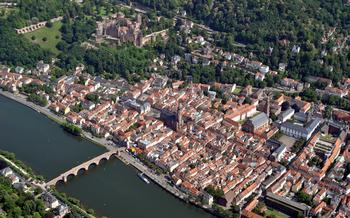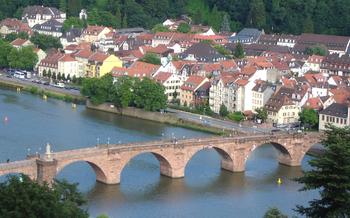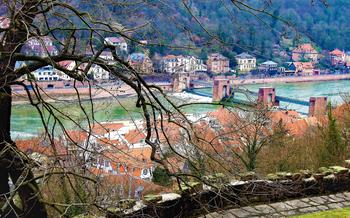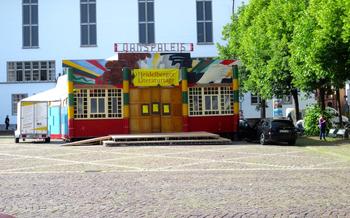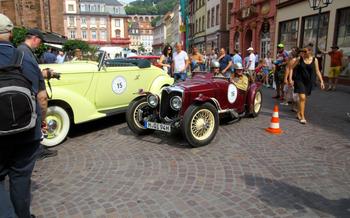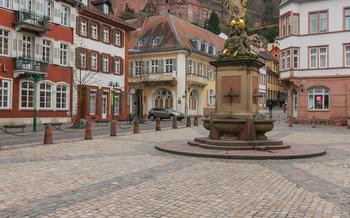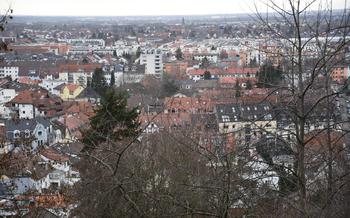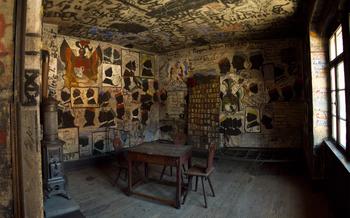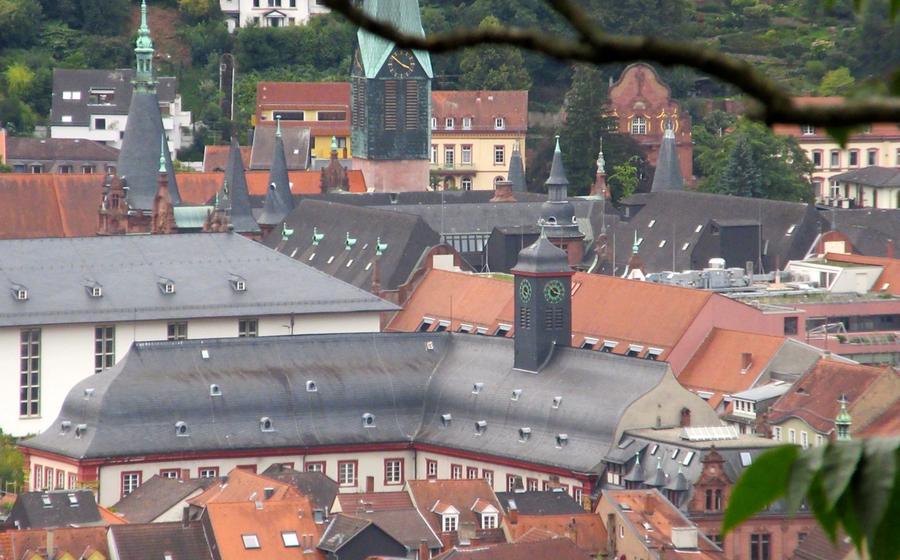
Old University (Alte Universität)
- Old University (Alte Universität): A Symbol of Knowledge and History
- History: Tracing the Roots of Knowledge
- Architecture: A Masterpiece of Gothic Design
- University Museum: A Treasure Trove of Knowledge
- Great Hall (Aula): Where History Unfolded
- Alte Aula (Old Assembly Hall): A Place of Learning and Debate
- Library (Universitätsbibliothek): A Sanctuary of Knowledge
- Student Prison (Studentenkarzer): A Glimpse into Student Life
- University Church (Universitätskirche): A Place of Reflection
- Philosophers' Walk (Philosophenweg): A Path of Inspiration
- Heidelberg University Today: A Thriving Center of Academia
- Practical Information: Planning Your Visit
- Tips for Making the Most of Your Visit
- Anecdotes and Legends Surrounding the Old University
- Insider Tip: Hidden Gems to Discover
Old University (Alte Universität): A Symbol of Knowledge and History
The Old University in Heidelberg, known as the Alte Universität, stands as a testament to the city's rich academic heritage. Founded in 1386, it is one of the oldest universities in Germany and has played a pivotal role in shaping the intellectual and cultural landscape of Europe. The university's stunning architectural beauty, its significant contributions to academia, and its current use as a museum make it a must-visit destination for anyone interested in history, architecture, and education.
The Alte Universität's architectural design is a harmonious blend of Gothic and Renaissance styles, showcasing intricate carvings, a striking facade, and a serene courtyard. Inside, the university's historic halls and lecture rooms, such as the Great Hall (Aula) and the Alte Aula (Old Assembly Hall), evoke an atmosphere of scholarly pursuits and intellectual debates. The university's museum, housed within the complex, takes visitors on a journey through the institution's rich past, showcasing exhibits on its founding, notable scholars, scientific instruments, and interactive displays.
History: Tracing the Roots of Knowledge
In 1386, the Elector Ruprecht I of the Palatinate, driven by a desire to promote education and scholarship, founded the University of Heidelberg. This momentous event marked the beginning of an institution that would become a beacon of knowledge and innovation in Europe. Initially, the university consisted of four faculties: theology, law, medicine, and philosophy. Over the centuries, it expanded, gaining renown for its contributions to various academic fields.
The university played a pivotal role in the development of Heidelberg, transforming it into a vibrant intellectual and cultural center. Scholars from across Europe flocked to Heidelberg, drawn by the university's reputation and the opportunity to learn from its distinguished faculty. The university's influence extended beyond the city walls, contributing significantly to the intellectual and cultural landscape of the European Renaissance.
Throughout its history, Heidelberg University has been associated with numerous notable scholars who made groundbreaking contributions to their respective fields. Among them were humanists like Marsilius of Padua and Samuel von Pufendorf, who left an indelible mark on the development of political thought. The university also nurtured scientific advancements, with figures like Johann Wolfgang von Goethe, who conducted groundbreaking research in botany and optics, and Robert Bunsen, renowned for his discovery of the elements cesium and rubidium. These scholars, along with many others, helped shape the university's legacy as a hub of intellectual achievement.
Architecture: A Masterpiece of Gothic Design
The Alte Universität stands as a testament to the architectural prowess of its time, blending Gothic and Renaissance elements to create a visually stunning masterpiece. Its facade boasts intricate carvings depicting biblical scenes and historical figures, each detail meticulously crafted to showcase the university's rich heritage.
The courtyard, with its serene atmosphere, provides a tranquil oasis amidst the bustling city. Surrounded by graceful arcades and adorned with delicate ornaments, it offers a glimpse into the university's peaceful scholarly environment.
Inside, the Alte Universität continues to impress with its vaulted ceilings, intricate stained glass windows, and ornate woodwork. Every corner reveals a new treasure, from the symbolic carvings on the banisters to the elaborate frescoes adorning the walls. The Great Hall (Aula), with its impressive dimensions and stunning interior, is a testament to the university's grandeur and academic prestige.
The Old Assembly Hall (Alte Aula), with its original wooden benches and podium, evokes the atmosphere of lively debates and intellectual discussions that shaped the minds of generations of students. The library, with its awe-inspiring collection of books and manuscripts, speaks to the university's dedication to preserving and sharing knowledge.
The Alte Universität is not merely a building; it is a living testament to the power of education and the enduring legacy of Heidelberg University. Its architectural beauty is a reflection of the university's rich history, academic excellence, and commitment to shaping the minds of future generations.
University Museum: A Treasure Trove of Knowledge
The University Museum, located within the Old University, is a treasure trove of knowledge and history waiting to be explored. Its exhibits showcase the university's rich history, from its founding in 1386 to its role in the European Renaissance and beyond. Visitors can marvel at a wide range of artifacts, including scientific instruments, historical documents, and rare books that tell the story of the university's contributions to academia.
Interactive exhibits make learning an engaging experience, allowing visitors to delve deeper into the university's past and its impact on the world. Guided tours are available for those who want a more in-depth understanding of the exhibits and their significance. The museum is a must-visit for anyone interested in the history of higher education and the intellectual heritage of Heidelberg.
Great Hall (Aula): Where History Unfolded
The Great Hall, also known as the Aula, is the heart of the Old University. This awe-inspiring space, with its high vaulted ceiling and intricate carvings, has witnessed centuries of academic ceremonies, historical events, and speeches that have shaped the course of history.
In its early days, the Great Hall served as a lecture hall for theology and law students. It was here that renowned scholars such as Martin Luther and Johannes Kepler imparted knowledge to generations of students. The hall's acoustics are said to be exceptional, allowing the professors' voices to carry throughout the room, ensuring that every student could hear their words clearly.
Over the centuries, the Great Hall has played host to numerous historical events. In 1613, the Elector Palatine Frederick V was crowned King of Bohemia within these walls, marking a significant moment in European history. The hall has also witnessed the signing of important treaties and agreements, including the Treaty of Heidelberg in 1795, which ended the War of the First Coalition.
Today, the Great Hall continues to be used for special events, concerts, and academic ceremonies. Its grand atmosphere and rich history make it a truly special venue for any occasion. Visitors to the Old University can admire the hall's stunning interior and learn about its fascinating past through guided tours or self-guided exploration.
Alte Aula (Old Assembly Hall): A Place of Learning and Debate
The Alte Aula, or Old Assembly Hall, is another significant building within the Old University complex. Constructed in the 16th century, this historic lecture hall has witnessed countless academic discussions and debates that have shaped the intellectual landscape of Heidelberg. Its original features, such as the wooden benches, the raised platform for the lecturer, and the intricate carvings on the walls, have been meticulously preserved, offering a glimpse into the university's rich history.
In its early days, the Alte Aula served as a venue for lectures, disputations, and examinations. It was here that renowned scholars engaged in lively debates on various subjects, from theology and philosophy to law and medicine. The walls of the Alte Aula reverberated with the voices of brilliant minds, challenging conventional wisdom and pushing the boundaries of knowledge.
Today, the Alte Aula continues to be used for conferences, lectures, and special events. Its historic ambiance and academic legacy make it a fitting venue for discussions on contemporary issues and scholarly pursuits. Visitors can almost feel the echoes of intellectual giants as they step into this venerable hall, inspiring them to engage in their own intellectual journeys.
The Alte Aula stands as a testament to the enduring power of knowledge and the vibrant intellectual community that has flourished within the walls of Heidelberg University for centuries. It is a place where ideas were born, challenged, and refined, leaving an indelible mark on the world of academia and beyond.
Library (Universitätsbibliothek): A Sanctuary of Knowledge
One of Germany's oldest university libraries, the Universitätsbibliothek Heidelberg, is a treasure trove of knowledge and a testament to the university's rich academic history. Its vast collection boasts over three million books, manuscripts, and rare editions, covering a wide range of subjects from theology and law to medicine and natural sciences.
The library's origins can be traced back to the university's founding in 1386, when it was established as a collection of books for the use of students and scholars. Over the centuries, the collection grew steadily through donations, purchases, and confiscations from monasteries and private libraries.
The library's reading room is a sight to behold, with its high vaulted ceiling, ornate chandeliers, and rows upon rows of wooden bookcases filled with leather-bound volumes. The atmosphere is one of awe and reverence, befitting a place where generations of scholars have come to study and research.
In recent years, the library has embarked on a comprehensive digitization project to make its vast collection more accessible to researchers and the general public. This initiative has resulted in the creation of a digital library, which allows users to access millions of books, manuscripts, and journals online.
The Universitätsbibliothek Heidelberg is a must-visit for anyone interested in the history of scholarship and academia. Its collection is a testament to the university's long-standing commitment to teaching and research, and its digitization efforts are ensuring that this legacy will continue to be accessible for generations to come.
Student Prison (Studentenkarzer): A Glimpse into Student Life
Tucked away within the Old University complex lies a unique attraction that offers a glimpse into the disciplinary history of Heidelberg University—the Student Prison (Studentenkarzer). This intriguing facility once served as a place of confinement for students who had broken university rules or engaged in unruly behavior.
The prison consists of a series of small, windowless cells, each equipped with a basic bed, a table, and a chamber pot. The walls are adorned with graffiti and inscriptions left by former inmates, providing a fascinating glimpse into the lives and thoughts of students from centuries past. Some of the inscriptions are humorous, while others express frustration or regret.
The Student Prison offers a unique opportunity to learn about the changing attitudes towards student discipline over time. In the early days of the university, students were often subjected to harsh punishments for minor offenses. However, as the university evolved, so did its approach to discipline, with a greater emphasis on rehabilitation and education.
Today, the Student Prison stands as a reminder of a bygone era and serves as a valuable teaching tool for students and visitors alike. It offers a unique perspective on the history of Heidelberg University and the evolving nature of student life.
University Church (Universitätskirche): A Place of Reflection
Adjacent to the Old University, the Universitätskirche stands as a testament to the university's deep connection to spirituality. Built in the Gothic style, this church exudes an aura of tranquility and reverence. Within its hallowed walls, religious services and university events are held, fostering a sense of community and reflection. The church's stained glass windows, depicting biblical scenes with intricate detail, cast a colorful glow, illuminating the interior with a divine light. As visitors step into this sacred space, they are enveloped in a serene atmosphere, inviting contemplation and introspection. The Universitätskirche serves as a reminder of the university's enduring commitment to fostering intellectual and spiritual growth, creating a harmonious blend of academia and faith.
Philosophers' Walk (Philosophenweg): A Path of Inspiration
The Philosophers' Walk, or Philosophenweg, is a scenic trail that winds its way along the Neckar River, offering breathtaking views of Heidelberg and the surrounding hills. Named after the university's famous philosophers, such as Hegel and Jaspers, who were known to stroll along this path while contemplating life's big questions, it has become a symbol of intellectual pursuits and inspiration.
The trail begins near the Old University and meanders for about 2 kilometers along the riverbank, passing through lush greenery and offering panoramic vistas of the city, the castle, and the picturesque Neckar Valley. Along the way, visitors can admire historic villas, charming gardens, and tranquil spots perfect for contemplation and reflection.
The Philosophers' Walk is not just a beautiful promenade but also a place where one can feel the palpable presence of the university's intellectual heritage. The serene atmosphere and stunning scenery have inspired generations of scholars, poets, and artists, making it a beloved destination for both locals and visitors alike.
Whether you're a nature enthusiast, a history buff, or simply someone seeking a peaceful retreat, the Philosophers' Walk is a must-visit attraction in Heidelberg. Take a leisurely stroll along the path, soak in the breathtaking views, and let the spirit of academia and inspiration wash over you.
Heidelberg University Today: A Thriving Center of Academia
Heidelberg University stands as a testament to the enduring power of knowledge and innovation. Today, it remains a vibrant center of academia, attracting students and scholars from around the world. The university offers a diverse range of academic programs and research institutes, spanning the humanities, social sciences, natural sciences, and medicine. Its commitment to excellence in teaching and research has earned it a distinguished reputation both nationally and internationally.
Beyond its academic achievements, Heidelberg University also boasts a vibrant student life and a rich cultural scene. The university campus is home to numerous student organizations, clubs, and initiatives, providing ample opportunities for students to engage in extracurricular activities, develop their skills, and make lifelong connections. The city of Heidelberg itself offers a lively and diverse cultural landscape, with theaters, museums, music venues, and festivals catering to a wide range of interests.
The university's commitment to innovation and progress is evident in its state-of-the-art facilities and resources. Modern lecture halls, laboratories, and libraries provide students with the tools they need to succeed in their studies and research endeavors. The university also places a strong emphasis on interdisciplinary collaboration, fostering a dynamic environment where ideas and knowledge can converge to create new insights and solutions.
As Heidelberg University looks to the future, it continues to uphold its tradition of excellence while embracing new challenges and opportunities. The university is actively engaged in cutting-edge research, contributing to advancements in fields such as artificial intelligence, climate science, and global health. Its commitment to internationalization and global partnerships ensures that Heidelberg remains a truly global university, where students and scholars from diverse backgrounds can come together to learn, collaborate, and make a positive impact on the world.
Practical Information: Planning Your Visit
Organizing a trip to the Old University (Alte Universität) in Heidelberg is easy and convenient. Situated in the heart of the city, it is well-connected by public transportation. Visitors can hop on trams or buses that stop nearby, making it accessible from various parts of Heidelberg. Once you arrive, the university's central location allows for easy exploration of other nearby attractions, such as the Heidelberg Castle and the Old Town.
Admission fees to the Old University are reasonable, with discounts available for students, seniors, and families. Guided tours are offered in English and German, providing an informative and immersive experience. Visitors can choose from various tour options, ranging from general overviews to in-depth explorations of specific areas.
For visitors with disabilities, the Old University is well-equipped with ramps, elevators, and accessible restrooms. The university strives to ensure that everyone has an enjoyable and inclusive visit, and staff members are always ready to assist with any special needs.
Tips for Making the Most of Your Visit
To fully experience the Old University and its rich history, allocate sufficient time to explore the entire complex. Rushing through will not do justice to its many treasures. Join a guided tour for a deeper understanding of the university's significance, architecture, and contributions. The knowledgeable guides will bring the past to life and provide insights into the stories behind the stones.
Don't miss the unique experience of visiting the Student Prison. Step into the cells where unruly students were once confined and marvel at the graffiti and inscriptions they left behind. It's a fascinating glimpse into student life in centuries past.
For a refreshing break and breathtaking views, stroll along the Philosophers' Walk. This scenic trail winds along the Neckar River, offering stunning panoramas of Heidelberg and the surrounding hills. It's the perfect place to let your thoughts wander and soak in the beauty of your surroundings.
Anecdotes and Legends Surrounding the Old University
The Old University is steeped in a rich tapestry of anecdotes and legends, passed down through generations of students and scholars. One enduring tale speaks of a mischievous student who, in a daring act of defiance, climbed to the top of the university's iconic tower and replaced the weather vane with a pair of old boots. The boots remained there for weeks, much to the amusement of students and the chagrin of the university authorities.
Another legend tells of a pact between the university's founder, Ruprecht I, and the devil. In exchange for the devil's help in building the university, Ruprecht promised to give him the soul of the first person to enter the completed building. True to his word, the devil appeared on the day of the university's inauguration, but Ruprecht outsmarted him by sending a cat through the door first. Furious at being tricked, the devil vanished, leaving behind a sulfurous smell that still lingers in the university's corridors.
These anecdotes and legends add a touch of whimsy and intrigue to the Old University's storied history, capturing the imagination of visitors and locals alike. They serve as a reminder that within the walls of this venerable institution, knowledge and tradition intertwine with a sense of playful mischief and enduring charm.
Insider Tip: Hidden Gems to Discover
Beyond the main attractions of the Old University, there are hidden gems waiting to be discovered by curious explorers. Keep an eye out for secret passageways and courtyards tucked away within the historic buildings. These hidden corners offer a glimpse into the university's rich past and provide unique photo opportunities.
The University Museum also holds lesser-known treasures that may escape the notice of casual visitors. Look for exhibits showcasing rare scientific instruments, forgotten manuscripts, and intriguing artifacts that tell the stories of the university's pioneering scholars and their groundbreaking discoveries.
For those seeking breathtaking views, venture off the beaten path to find secluded spots within the university complex. The rooftops of some buildings offer panoramic vistas of Heidelberg's charming cityscape and the picturesque Neckar River. These hidden vantage points are perfect for capturing stunning photographs and creating lasting memories of your visit to this iconic university.
Whether you're a history buff, an architecture enthusiast, or simply someone who appreciates hidden gems, the Old University in Heidelberg promises an unforgettable experience. With its wealth of knowledge, captivating stories, and hidden surprises, this historic institution continues to inspire and intrigue visitors from around the world.
